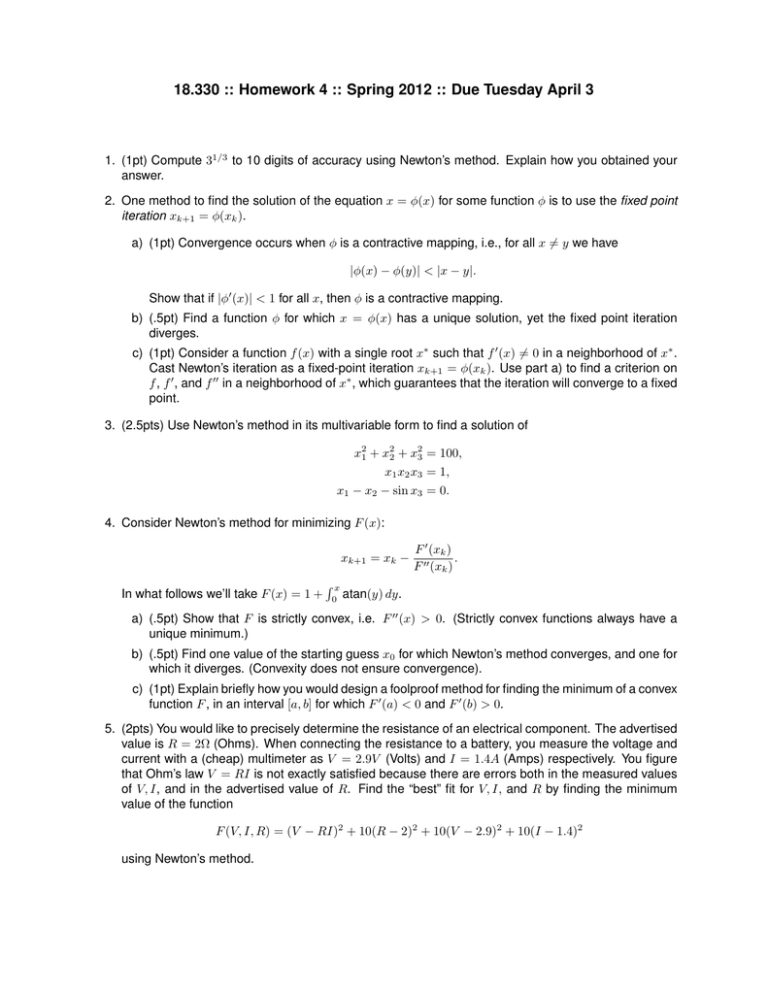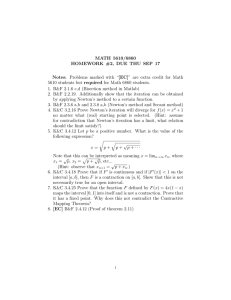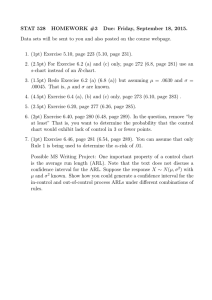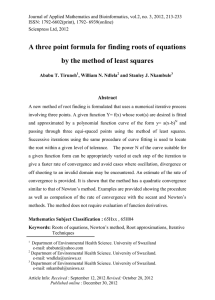18.330 :: Homework 4 :: Spring 2012 :: Due Tuesday...
advertisement

18.330 :: Homework 4 :: Spring 2012 :: Due Tuesday April 3 1. (1pt) Compute 31/3 to 10 digits of accuracy using Newton’s method. Explain how you obtained your answer. 2. One method to find the solution of the equation x = φ(x) for some function φ is to use the fixed point iteration xk+1 = φ(xk ). a) (1pt) Convergence occurs when φ is a contractive mapping, i.e., for all x 6= y we have |φ(x) − φ(y)| < |x − y|. Show that if |φ0 (x)| < 1 for all x, then φ is a contractive mapping. b) (.5pt) Find a function φ for which x = φ(x) has a unique solution, yet the fixed point iteration diverges. c) (1pt) Consider a function f (x) with a single root x∗ such that f 0 (x) 6= 0 in a neighborhood of x∗ . Cast Newton’s iteration as a fixed-point iteration xk+1 = φ(xk ). Use part a) to find a criterion on f , f 0 , and f 00 in a neighborhood of x∗ , which guarantees that the iteration will converge to a fixed point. 3. (2.5pts) Use Newton’s method in its multivariable form to find a solution of x21 + x22 + x23 = 100, x1 x2 x3 = 1, x1 − x2 − sin x3 = 0. 4. Consider Newton’s method for minimizing F (x): xk+1 = xk − In what follows we’ll take F (x) = 1 + Rx 0 F 0 (xk ) . F 00 (xk ) atan(y) dy. a) (.5pt) Show that F is strictly convex, i.e. F 00 (x) > 0. (Strictly convex functions always have a unique minimum.) b) (.5pt) Find one value of the starting guess x0 for which Newton’s method converges, and one for which it diverges. (Convexity does not ensure convergence). c) (1pt) Explain briefly how you would design a foolproof method for finding the minimum of a convex function F , in an interval [a, b] for which F 0 (a) < 0 and F 0 (b) > 0. 5. (2pts) You would like to precisely determine the resistance of an electrical component. The advertised value is R = 2Ω (Ohms). When connecting the resistance to a battery, you measure the voltage and current with a (cheap) multimeter as V = 2.9V (Volts) and I = 1.4A (Amps) respectively. You figure that Ohm’s law V = RI is not exactly satisfied because there are errors both in the measured values of V, I, and in the advertised value of R. Find the “best” fit for V, I, and R by finding the minimum value of the function F (V, I, R) = (V − RI)2 + 10(R − 2)2 + 10(V − 2.9)2 + 10(I − 1.4)2 using Newton’s method. MIT OpenCourseWare http://ocw.mit.edu 18.330 Introduction to Numerical Analysis Spring 2012 For information about citing these materials or our Terms of Use, visit: http://ocw.mit.edu/terms.








